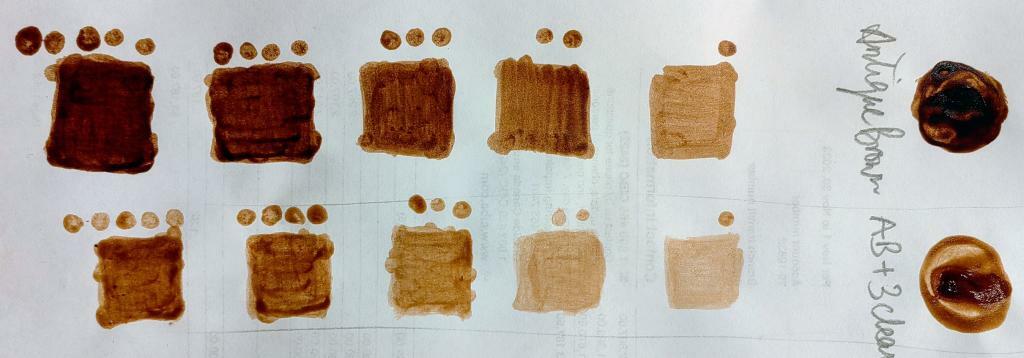Product Overview
Aniline Gloss Coating Dye 76 by Leather Doctor® is a next-generation water-based transparent surface coating dye formulated for vivid, brilliant color coverage on leather.
Unlike traditional penetrating dyes, Aniline 76 forms a transparent surface film, enhancing color intensity, uniformity, and gloss while preserving the natural beauty of the leather grain.
Aniline 76 Key Features:
Transparent coating allows the natural grain to show through — akin to varnishing fine wood.
Provides bright, vivid color enhancement over existing aniline or bronzing-stained dye effects (e.g., over Aniline Staining Dye 21).
Revitalizes and enriches aged or faded finishes without masking the leather’s character.
Suitable for use as a final color gloss coat or layered over base dyes.
Water-based, leather-safe formula compatible with Leather Doctor® systems.
Comparison:
| Property | Aniline Gloss Coating Dye 76 | Leather Pigment 54 |
|---|---|---|
| Type | Transparent surface coating dye | Micro-pigment paint-like finish compact resin |
| Grain visibility | High (grain shows through like wood varnish) | Low (masks imperfections, solid opaque look) |
| Application purpose | Enrich color, gloss, retain natural look | Camouflage damage, uniform solid appearance |
A 1:1 mix (Pigment 54 : Aniline 76) produces a translucent hybrid finish.
Best used when moderate damage needs camouflaging while preserving some grain visibility. This offers a balance between optimal appearance and a natural tactile feel.
Recommended Uses:
Final gloss color coat over Aniline 21 bronzing stain effects
Restoration of faded or uneven aniline finishes
Hybrid finishes for damaged aniline or semi-aniline leather
How Does Transparent Aniline Coating Dye 76 Work?
Layered Transparency
Like watercolor painting, color intensity builds up with each layer. The more layers, the deeper the color.
Overlapping Strokes
Applying strokes on top of each other increases color depth, enabling shading and visual richness.
Diluting for Lighter Shades
To achieve a lighter or more subtle tone, dilute the original dye with the 'Clear' component.
Always Test First
Conduct a color test before full application to confirm the desired outcome.
Test Application Method
Different tools and methods can yield varied results. Always test your application approach beforehand.
Recommended Tool: Airbrush
For best consistency, use an airbrush with 80 to 100 psi pressure.
Other Methods
Varnishing brushes or folded towels can also be used but may produce more artistic or varied results.
Two Shading Techniques
Method 1: Airbrush
- Apply fine, even coats with a Paasche airbrush for a smooth, professional finish.
Method 2: Hand Brushing or Padding
- Use brushes or padding for a “salvage” look, emphasizing artistic or antique-style shading.
Pre-Mixing with ‘Clear’
Mix with 'Clear' before application to control the starting intensity. Depending on the tool used, the finish can range from clean and uniform to uniquely shaded.

Shading Example: Antique-Brown shading with 'Clear'.
Refer to the image antique-shading-with-clear.jpg:
- First Row: Undiluted Antique-Brown applied with increasing layers from right to left.
- Second Row: Antique-Brown mixed with 3 parts ‘Clear’, with intensity increasing from right to left.
The shading in this example is achieved using a cotton bud to demonstrate overlapping and blending effects — perfect for visualizing the "salvage" technique.
Aniline Leather Gloss Re-Dyeing Process with Aniline 21, Aniline 76, and Pigment 54
1️⃣ Surface Preparation
✅ Clean & degrease:
- Clean with Prep 7.7 → Soft 3.8 → Rinse 3.0 (remove body oil, soiling).
- If necessary, degrease with Degreaser 2.2 + Acidifier 2.0 on oily spots.
✅ Dry fully before dyeing.
2️⃣ Base Staining Dye — Aniline Staining Dye 21
Purpose: Deep transparent stain; creates vibrant undertone; evens out faded areas.
- Apply by airbrush / sponge / padding cloth.
- Build up color gradually in thin coats; let each layer dry before next.
- Allow full drying (12–24 hours recommended).
3️⃣ Surface Color Gloss — Aniline Gloss Coating Dye 76
Purpose: Transparent glossy surface color, intensifies base dye, adds depth & brilliance.
- Apply in light even coats by spray or sponge.
- Allow drying between coats (can do 1–3 coats depending on desired gloss & intensity).
Optional hybrid:
- Mix Aniline 76 : Pigment 54 = 1:1 for a translucent coating that helps camouflage blemishes while retaining some grain visibility.
4️⃣ Topcoat Sealer
- For extra protection, seal with Aniline Finish Topcoat Gloss 76, Leather Finish Topcoat Matte 54 or Leather Finish Topcoat Satin 54.
- (Matte/Satin/Gloss) or Protector B / B+.
5️⃣ Rub-Resistant Conditioner
Aniline/Pigment Refinishing Example
| Dye/Pigment Type | Product/Ratio | Function |
| Structure Dye Staining | Aniline 21 | Transparent Staining Effect - Enhances the natural beauty, depth, and character of the leather grain. |
| Surface Dye Coating | Aniline 76 | Transparent coating allows the natural grain to show through — akin to varnishing fine wood. |
| Surface Pigment Coating | Pigment 54 | Opaque, paint-like appearance — effectively conceals surface imperfections and repairs. |
| Surface Hybrid Coating | 1:1 Pigment 54 : Aniline 76 | Translucent, masks damage, cover blemish, retains gloss |
How is Random Two-Tone Leather Design Created?
Related Product
Aniline Leather Redyeing Kit A7.cl
A complete solution for restoring and recoloring aniline leathers with precision and artistry.
Updated: April 8,, 2025 | July 4, 20125 | July 5, 2025 by Roger Koh






